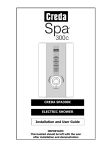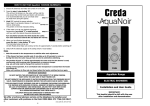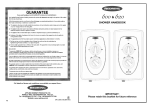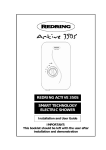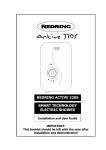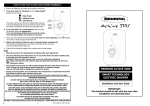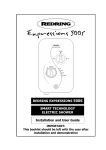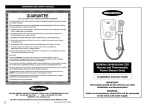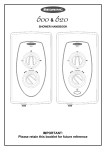Download SHOWER HANDBOOK
Transcript
SHOWER HANDBOOK After Sales Service We offer a technical advisory service on the telephone to installers and other customers with problems in the field. RING 0844 372 7766 (UK ONLY) Remember to quote the exact type of shower, as written on the front of the shower and on this leaflet. The model and serial number are located on the bottom face of the sh ower. Make a note of those numbers here, and be sure to quote them if you call for advice. Model Number: 53-_ _ _ _ _ _ _ _ _ / Serial Number: _ _ _ _ _ _ _ _ _ _ _ Note: You may be charged for a service call if you do not have the serial number. Full details of terms and conditions are available on request from: - Applied Energy Products Ltd, Morley Way, Peterborough, PE2 9JJ Website : www.creda-showers.co.uk 12 (A3 Leaflet: 559-2355-40B) IMPORTANT This booklet should be given to the customer after installation and demonstration. 1 Thank you for choosing a quality “Creda” product manufactured in Peterborough, England. This page has been left blank for the addition of any notes you may wish to make: - Contents User information How to use your shower Routine Maintenance How your shower works Troubleshooting Available spares Page 2 4 5 6 10 Installer Information Fixing the shower to the wall Plumbing Electrical Commissioning Guarantee Page 8 9 9 10 12 Warning Do Not Switch The Shower On If You Suspect It Of Being Frozen, Wait Until You Are Sure That It Has Been Completely Thawed Out. How To Use Your Shower Switch On Electricity at ceiling / isolating switch. Press Start /Stop Button in the centre. (Confirmed with a single bleep) The unit will start and the motorised valve will reset. Display will usually light up number 1. The digit will increase until display shows number 6. The average showering temperature. When the unit has got close to this setting it sounds a double bleep and the unit is ready for use. The unit will only count up & double bleep once per shower session. Flow light will be on high. To Increase Temperature - Press the warmer button once in the centre (Confirmed with a single bleep). The number will change to the new setting. i.e. Display will change from digit 6 to digit 7 Wait for a few seconds for the shower to increase the temperature to the new setting. Repeat this for your ideal setting waiting each time for the temperature to be achieved. (Maximum setting is digit 9). To Decrease Temperature - Press the cooler button once in the centre (Confirmed with a single bleep) The number will change to the new setting. i.e. Display will change from digit 6 to digit 5 Wait for a few seconds for the shower to decrease the temperature to the new setting. Repeat this for your ideal setting, waiting each time for the temperature to be achieved 2 11 d) Commissioning To Change Flow Rate Ensure the water and electricity are switched on to the unit. Press the START/STOP button then change the temperature setting to number 1 by pressing the COOLER button 5 times. Press the flow button in the centre (Confirmed with a single bleep) If the button does not respond, ensure that the flying lead from the PCB has been connected to the front cover (fig 12). This reduces the flow without changing the temperature setting. (Note: As the flow changes, the water temperature may go up and down slightly) Allow the unit to fill and wait for the water to come out of the handset. Press once and the flow will reduce to medium. Change setting up to number 6 by pressing the warmer button, check that the outlet temperature increases to comfortable temperature and that, when pressing the flow button t he flow does change. Press it again and it will reduce to low. Check for leaks. On switching on the shower, the flow always comes on in the high flow condition. Press START/STOP button to switch the unit off. This completes the commissioning. Demonstrate Operation To User. Please leave these instructions with user for future reference. Switching Off Spare Parts (RING 0844 372 7750) When you have finished showering press the start /stop button in the centre. See fig.1 (Confirmed with 3 short bleeps) Spare parts Cat No. Solenoid valve + seals 93-594101 Triac PCB 93-594102 Flow transducer 93-594117 Flow assembly + motor (no outlet) 93-594104 Valve motor 93-594105 Cutout assembly + cables 93-590326 Hose outlet assembly complete 93-594110 Cable entries (top / bottom) Grey 93-594129 Side section (Grey) 93-594130 Logic PCB 93-594118 Front cover assembly complete 93-590359 P.R.V. housing complete 93-594115 Cable pack (all internal cables) 93-594116 1.25m Chrome Shower Hose 93-797641 Please Note:- The fitting of all spares should be supervised by a suitably qualified person. 10 The water will continue to run for a few seconds so that the unit is cooled down ready for the next time the shower is used. While this is happening the display will circle round and round (see fig.5). The unit will then switch off automatically. Switch Off Electricity at ceiling / isolating switch. Over Temperature Shutdown If an abnormal condition occurs which causes the water to get too hot, the unit will automatically shutdown straight away and the water will stop flowing. This is to prevent any hot water coming out of the handset. This is indicated by 8 short bleeps and the display flashing a lowercase “o” and then “t” (see fig.6). This will continue until the water is at a safe temperature. The unit will then switch off automatically and will need to be restarted in the normal way. It can take a long time for the unit to reach a safe temperature. To speed this temperature reduction up, the hot water can be purged from the unit. 3 Fig.5 Purging b) Plumbing While the unit is in Over Temperature shutdown mode press the cooler and flow button together for 20 seconds. (See fig.7) We recommend that a WRAS (Water Regulations Advisory Scheme) listed isolating valve be fitted between the rising main and the unit. This will allow the unit to be serviced without having to turn off the house water at the stop valve. This will switch the water on only while the buttons are pressed. The unit should be connected to the mains cold water supply. This must have a minimum running pressure of 0.07 MPa (0.7bar / 10 p.s.i.) and a maximum pressure of 1MPa (10bar /145 p.s.i.) Caution!! Water Will Be Hot stand clear of the spray from the The unit can be fed from a header tank provided this has a minimum head of 7 metres (23ft). handset. The unit will then switch off automatically with 3 short bleeps when a safe water temperature has been reached. In Order To Maintain The Performance Of Your Shower You Must Clean The Shower Head Regularly. All water contains particles of lime-scale, which build up in the showerhead and unit reducing the performance. It is therefore important to clean the showerhead by simply rubbing the rubber nozzles or soaking in proprietary lime-scale remover and rinsing thoroughly before use. The frequency of this will vary from weekly to quarterly depending on the water hardness and experience. In some winter conditions, when the incoming mains water is particularly cold it may be necessary to select the inner or outer spray pattern only; this will ensure correct operation of the shower with a slightly lower water flow rate. After use it is normal for some water to drip from the spray head for a few moments. This helps prevent scale build up over prolonged use. Routine Maintenance It is recommend that as well as checking the showerhead as detailed above, the shower unit, riser rail, hose etc. be cleaned using a soft cloth and that the use of abrasive or solvent based cleaning fluid be avoided, especially on any plated finishes. We recommend that before any cleaning, the isolating switch be turned off, thus avoiding accidentally switching on the shower. You Must Regularly Inspect The Shower Hose For Wear And Damage. Replace If Necessary, Or Every Two Years, With Our Approved Part. This appliance is not intended for use by persons (including children and the infirm) with reduced physical, sensory or mental capabilities, or lack of experience and knowledge, unless they have been given supervision or instruction concerning use of the appliance by a person responsible for their safety. Children should be supervised to ensure that they do not play with the appliance. Standard Ø15mm copper or stainless pipe should be used. Connection to the unit is via a Ø15mm plain shank on the solenoid valve. A compression elbow or push fit connector can be used. (Stainless pipe is not recommended for push fit). Using an Isolating valve, flush the pipe work through to remove particles etc., before making the final connection to the shower. A blockage in the waterways (particularly the spray plate and solenoid valve) will prevent the unit from working correctly. The shower is designed to have an open outlet and should only be used with the fittings recommended by the manufacturer. Warning!! Do Not Fit A Tap On The Shower Outlet. Take Care To Avoid Restricting The Outlet Of The Pressure Relief Device. (See fig. 8 for location) Fig.10 c) Electrical Connections The electrical installation must be in accordance with the current BS7671 (I.E.E. wiring regulations) and “Part P” of the Building Regulations and/or local regulations. The cable connected to the appliance must be fixed wiring, and should be stripped back according to fig.11 Connect the cable to the terminal block. Ensure that all the retaining screws are VERY tight and that no cable insulation is trapped under the screws. Warning: Failure To Comply With These Instructions Could Result In A Failure Of The Terminal Block. Warning : This Appliance Must Be Earthed Replace the side section along with seal. IMPORTANT! Connect flying lead from PCB to front cover as shown (fig. 12). Replace the front cover and fasten in position with three screws. 4 Fig.11 The unit is designed for a single phase 50 Hz a.c. electrical supply. Please check the rating plate on the unit to see what details apply to your unit. A means for disconnection in all poles must be incorporated in the fixed wiring in accordance with the wiring rules. We recommend ceiling switches. 9 Fig.12 Installation Instructions How Your Shower Works ALL WIRING AND INSTALLATION MUST BE SUPERVISED BY A SUITABLY QUALIFIED PERSON. 1. Water is heated instantaneously as it flows over the heaters in the plastic heat exchanger assembly. 2. The shower automatically adjusts the power to the heating elements and flow of water to achieve the selected water temperature. The electronics senses the incoming water temperature and the flow of water through the heat exchanger. It then works out how many heaters to switch on so that the shower temperature matches the temperature selected by the buttons. 3. The amount of hot water available at the selected temperature is limited by the total power of the heater. The ideal flow rate is calculated and adjusted automatically. 4. The water is turned on and off by the solenoid valve built into the shower. 5. A stabiliser is built into the flow valve to automatically compensate for small fluctuations in water pressure that frequently occur in households. There are three further controls to cater for exceptional reductions in water pressure to prevent the shower from getting too hot. We recommend that the installation be done in the following sequence: a) b) c) d) Fix the shower to the wall Plumbing Electrical connections Commissioning Warning. Do Not Install The Shower In A Room Where It May Be Subject To Freezing a) Fix The Shower To The Wall When deciding where to place the unit a few things need to be taken into consideration: 1) The unit must not be mounted directly in the path of the spray from the handset 2) The handset could be used over a sink for hair washing. 3) The handset does not come into contact with the used water in the cubicle, bath or basin. A hose retainer is supplied with the accessories (see separate instructions supplied with accessories). 4) Choose a flat piece of wall to avoid the possibility of distorting the backplate and making the front cover a poor fit. Remove the three cover screws and lift the cover off. Remove side section complete with seal. Depending on which water entry is being used (top or bottom) break out the relevant rear support rib using a pair of pliers. (See fig.9) Identify which pipe and cable entry needs to be cut to enable the services to enter the shower (top or bottom, no trimming required for rear entry) then fit them to the backplate. (See fig.9) Hold the shower vertically against the wall and mark the top hole first. a) If the flow of water is less than 1.0 l/min the power to the elements is switched off, but the solenoid valve remains open allowing water to flow through the shower. Drill the hole to take the rawl plug provided (taking care to keep dust away from the shower). Put the top screw in first leaving it proud by 5mm approx. The shower can now be hung on this screw. Position the shower so that it is vertical then mark and drill the other two holes. Then fix the shower to the wall. b) If the outlet temperature sensor senses an excessive temperature the flow of water and the heating elements will automatically switch off. The electronics will signal over temperature condition (see “over temperature shutdown” section). Fig.9 (Rear View) c) A two stage mechanical thermal cut-out is mounted on the top of the heat exchanger independent of the electronics. Stage one switches the power off to the elements if it senses an excessive temperature. The switch operates with an audible click and will reset if cold water is run through the shower. Stage two only operates if an extreme temperature is sensed. The cut out will permanently switch off and it will then have to be replaced. Fix the riser rail with screws provided (see separate instructions supplied with accessories). Assemble the accessories as shown in the separate instructions supplied with accessories. 6. 8 Fig. 8 A pressure relief device is fitted to safeguard against other extreme conditions , and provides a level of appliance protection should an excessive build of pressure occur within the shower. If this operates a replacement part will be required. 5 Troubleshooting Professional Service Check List If the performance of the shower deteriorates in service, follow the checks in the “self help” table below before calling out the contractor. Any one of the simple adjustments could restore the per formance. This additional checklist is provided for the benefit of the qualified service representative. Warning. Switch Off The Electricity At The Isolating Switch Before Removing The Front Cover To Make Checks. If these fail to restore the performance you should seek professional help. The person who installed the shower is probably the best one to repair it and is certainly the person to contact if you have a problem in the guarantee period. a) Poor temperature control Check inlet / outlet thermistors to see if they are in circuit. Check for blockage in filter of solenoid valve Check board configuration for correct power rating b) Water too COLD Check circuit through thermal cut-out Check circuit through all 4 elements. Test should be done using a low voltage resistance meter whilst the power is switched off at the isolating switch Check circuit through triacs Check working voltage c) Poor or no control over water flow Replace inlet valve assembly d) No water when start button is pressed. Check water supply. Check circuit through solenoid coil. If ok replace logic PCB e) Unit has been switched off using stop button but can be heard heating the water Replace triac PCB f) Pressure relief valve operated Check for cause of high pressure and remove it. Replace pressure relief valve (Not covered under guarantee). Self Help Check List a) Water too HOT Press the cooler button. Clean spray plate holes. b) Water too COLD Press the warmer button. c) Spray pattern poor Clean spray plate. Select outer / inner only d) Display behaves erratically Switch off electricity at ceiling / isolating switch, wait a few seconds, switch on again. (Note the shower should be switched off each time after use at the ceiling switch.) e) Water does not flow when start/stop button is pressed Note: If there is no water flowing then the shower will automatically switch off after about 5 seconds. lights on Check the water supply is turned on. “o” and then “t” flashing in display Unit in over temperature mode see section on “purging” no lights Check ceiling switch is on. Check power is on. g) Temperature buttons only adjust between 2 and 5 Contact Customer service f) Warmer / cooler buttons only adjusts between 2 and 5 See relevant section in professional help h) Shower runs for about 5 seconds and then switches off by itself Flow transducer fault. Check that internal blade “spins” when the water flows : If not, replace transducer. g) Unit makes a whirring noise, especially at the start of the shower session. This is normal. There is a motor inside the shower used to adjust the flow and this always operates at the start of each shower. 6 7






